(Strand)om Stories: Wolfpack: The Complete Collection Review
This obscure series is engaging yet unbalanced, torn between the two stories it wants to tell
—by Nathan on August 23, 2025—
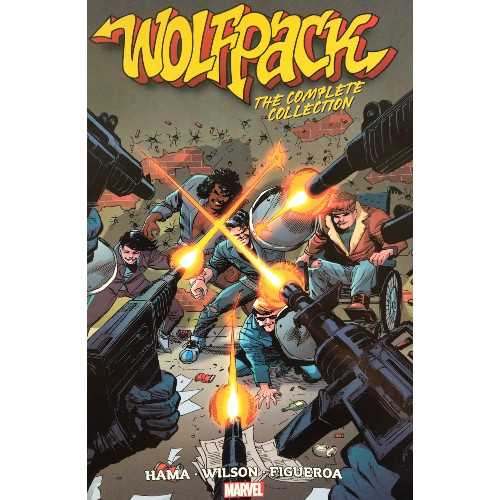
Normally, when I begin writing these reviews, I expect a level of familiarity with the subject at hand on the part of readers, as most of the characters I discuss are popular enough inside and outside comic fandoms. You see Spidey pop up on the page, you know who he is, his real name, his origin. Same with Batman, Superman, Iron Man…and, in large part thanks to cinematic universes, the list of familiar faces in comicdom has expanded over the past couple of decades. People are more familiar with guys like Blade, Shazam, Peacemaker, Shang-Chi. If I can't rely as much on familiarity, hopefully I know some interesting tidbit to kick things off–why Jack Kirby left Marvel for DC, for example–a touch of history to provide context and weight to the stories I'm reviewing.
I do not possess either tool in this case to hook you today, dear reader.
Today's review involves a title that lies squarely in the "obscure" side of the Marvel Universe, a collection which pulls in a graphic novel and twelve-issue limited series that I'd guess the vast majority of superhero movie fans are completely ignorant of and that even the good majority of Marvel Comics fans are either oblivious to or have never read. It's my job, as one of the guys who has actually read this volume, to convince you of whatever redeeming qualities it may possess, if any.
To begin: the creative teams. We've got names like Larry Hama, Ron Wilson, Whilce Portacio, and Kyle Baker associated with this book. My primary reason for reviewing this now is because I recently tackled a few other projects written by Hama, neither of which were fantastic. Though those reviews focused on Sabretooth and Wolverine narratives, and even though this volume has "Wolf" in its title, this series wasn't some Wolverine spinoff featuring several people with adamantium-laced claws. No, this series is much more grounded, a street-level title featuring drug dealers, gang warfare, and ninjas. Even with some high profile names attached to the narratives, we'll have to see if this Wolfpack will have you baying at the moon delightfully or snarling with frustration.
Wolfpack: The Complete Collection
Writers: Larry Hama, Ron Wilson, and John Figueroa
Penciler: Ron Wilson
Inkers: Whilce Portacio, Kyle Baker, Chris Ivy, Dave Hunt, and Tex Blaisdell
Colorists: Petra Scotese, Christine Scheele, Glynis Oliver, John Wilcox, and Evelyn Stein and Co.
Letterers: Jon Rosen, Jack Morelli, Michael Heisler, and Diana Albers
Issues Collected: Marvel Graphic Novel #31, Wolfpack #1-12, and material from Marvel Comics Presents #11 and #23
Volume Publication Date: August 2018
Issue Publication Dates: August 1987, August 1988-July 1989
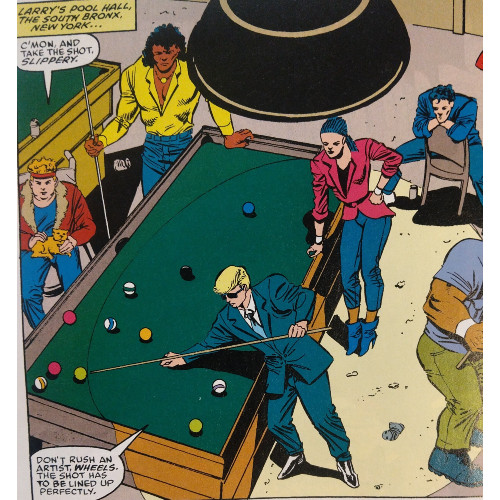
I've stated my reasoning for reviewing this collection now, but my initial thinking for why I picked up the volume originally was because of the included graphic novel, the 31st in Marvel's oversized graphic novel line. I've previously discussed other graphic novels in this line (and intend to review some more in the relatively near future), and I've noted in the past that the quality dips the deeper you dive. A series of high-end narratives beginning with the emotional death of a cosmic hero gradually loses its soul, transforming into a series of typical comic narratives that boast a longer page count and maybe a slight touch-up in the art department.
The Wolfpack graphic novel isn't genius or stirring, but it adequately lays the narrative groundwork, and other than being a little exposition heavy at times, does well to establish our characters, define their personalities and relationships, and methodically introduce the larger conflict which spills out into the rest of the series. It's a pretty entertaining standalone story, and were I reviewing it on its own, I'd be satisfied with how it ends, even with some leftover dangling plot threads. Ron Wilson capably develops settings which feel real–a school, a rooftop where our heroes often meet, apartments, and dingy city blocks–creating a world for our protagonists to inhabit. Action sequences include fistfights and a daring prison break, all illustrated with the savvy of an experienced artist who can make us feel we walk through these same streets as our heroes.
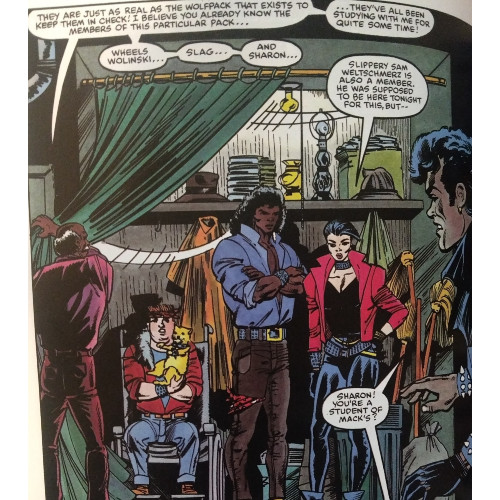
The following series ends up being a little more imbalanced in execution, and this is primarily because it wants to tell two stories; while they're not two completely different stories, Wolfpack the limited series never finds the right balance necessary to adequately tell both. Once Hama clears out after the third issue, Jon Figueroa is left trying to work his way through the compromises Hama has already introduced. It's a noble effort from both writers, particularly Figueroa as he handles most of the writing here, but cohesion is never perfectly achieved.
On the surface, Wolfpack wants to deliver an urban ninja story, combining a cast of street-wise, diverse youth with kung-fu action, grounded violence, and a gritty conspiracy based in ancient lore. There is a "chosen ones" angle presented here, as our five heroes–leader Rafael, whiz kid "Slippery" Sam, strategist Wheels, powerhouse Slag, and speedy Sharon–take on the roles previously filled by ancient martial artists in a battle against the insidious Nine, an organization employing ninjas, samurai, and gangsters to maintain a foothold in Brooklyn through drugs, murder, and other criminal activities. There's a "Chaste vs. the Hand" element borrowed/copied from Frank Miller's original Daredevil run found in these stories, without the radar sense, mysticism, and other superheroics.
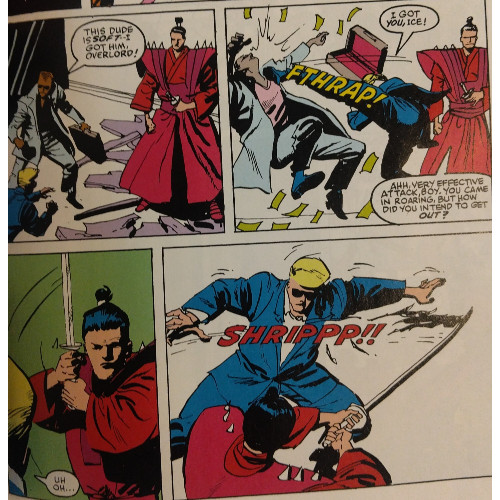
Look deeper, and you'll find that second story, one which is concerned with social commentary. Though Wolfpack, according to the Marvel fandom database, exists in Earth-616, there are absolutely no references to superheroes or vigilantes of any kind (making me think the "616" label is a mistake, and these issues take place within their own continuity). No superheroes swing or fly in to save the day, and no magic, crazy technology, or radioactive vats of waste give this series even the faintest trace of superhuman DNA. This means Hama and Figeuroa can keep this series as grounded as they possibly can, and it's here where the series tells its best tales.
The creators want to tell gritty stories which could hypothetically work in our universe, and they use an earnestness which gives most of the material credence. The series can be brutal in depicting the darkness of this urban setting–a careless driver runs over two children, a kid belonging to a gang takes a potshot at one of our heroes, drugs are sold in a high school, and gang war breaks out–but the grim brutality feels appropriately weighty. There are genuine consequences to people's actions, whether it's shooting up drugs or shooting at gang members, and you're led to shake your head and consider the real possibility that there are kids, in our world, who are addicted to drugs, sell drugs, have handled weapons, or have killed people. These kinds of actions can really happen, and Hama and Figeuroa point that out without harping on the issues or making the series feel like an extended PSA or anti-drug comic. Wolfpack is determined to prevent youth from engaging further in these lifestyles, and they will tell kids to quit, but the writers avoid the sentimental, sappy writing I feel is often found in narratives which attempt to tackle genuine problems.

The anti-drug/anti-gang messaging that is present works as well as it does, partly because the writing avoids cliches, but also because many of the problems presented are attached to our protagonists. Sharon convinces her father to watch after a young boy regularly abused by his parents; Wheels has to decide whether to take revenge on a thug who murders someone close to him; Sam wants to bring in thugs who break into his father's store. Not every narrative has a connection to our heroes–and not every connection to our heroes, I'll admit, necessarily works–but enough of the stories are structured around them to keep the issues personal. These teenage ninjas don't come as a heroic saviors who stand above the people they rescue and correct; they live in the muck and mire with everyone else.
As far as heroes go, our Wolfpack is appropriately flawed. They're relatively young, maybe around the same age as characters such as Peter Parker or Johnny Storm were when they began their illustrious careers, high schoolers with notable skills that draw them into this conflict. They can be emotional, they make mistakes, they develop friendships and deeper relationships with each other. You're asked to debate with them, along with a disgruntled police inspector, the impact of their vigilante actions, whether they'd be better off leaving the Nine and their lackeys to the police. The characters tend to be more defined by their physical traits than their individual personalities–Wheels gets around in a wheelchair, Slag is a muscular young man–which often take a back burner to their collective identity. Individual arcs exist by the issue, so overall, you're not going to see much of a change in each member from the first Wolfpack story to the last.
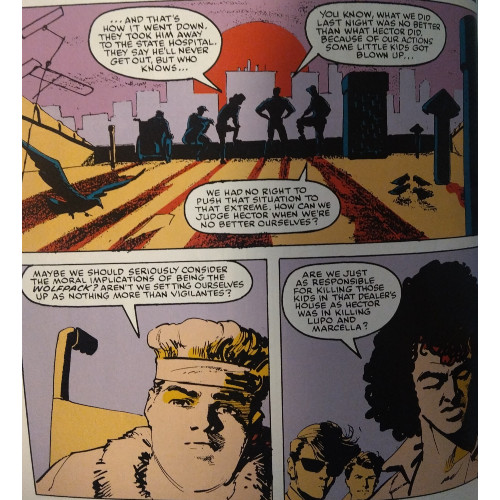
Waiting to boil on that back burner as well is the overarching "Wolfpack vs. the Nine" story, which plays second fiddle to the social commentary running through. The Nine are always a presence felt throughout the series, mentioned periodically as having an interest in Brooklyn, but they don't make waves until the very end of the series, and the final issue which wraps the whole story feels rushed. The Nine's agents pop up from time to time–a samurai warrior, a powerful member who is also one of the Wolfpack's member's fathers, a drug dealer–but they remain shadowy and unknowable. The series seems somewhat self-aware of this, as "Slippery" Sam often accuses the Wolfpack of setting their sights on dealing with street-level crooks without considering the larger threat, but this only ever remains a complaint. The story doesn't fully embrace the conflict until the very end, leaving the Nine plot feeling less important and somewhat unfinished.
This Wolfpack hunts and, while they don't bring in measly scraps, they don't quite track down the meaty narrative which could have made this series more fulfilling. Hama and Figueroa supply sufficient effort and creativity to make the street-level issues and scenarios feel largely believable and treat them seriously enough to serve as strong thematic points throughout the series. Our Wolfpack collectively serve as strong heroes, even if individual development could have more focus, yet they fight a fairly nebulous threat, their primary opponents never feeling more than smoky tendrils of influence passing through Brooklyn. I think the larger plot is needed to help prevent this series from crossing into finger-wagging, "Don't do drugs, kids" territory, but it feels less weightier than it should. Maybe the writers should have listened to their own character instead of letting his admonition "slip" past their ears.